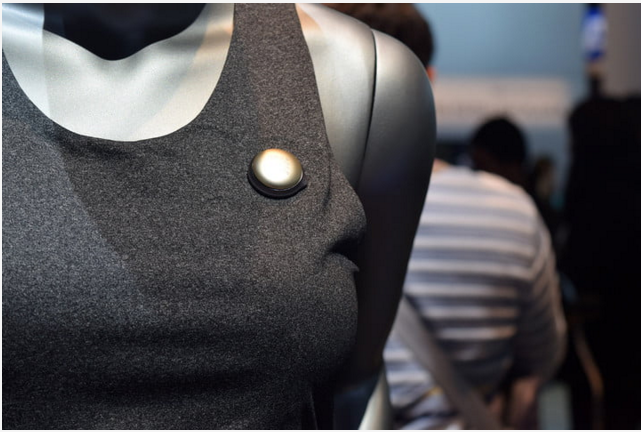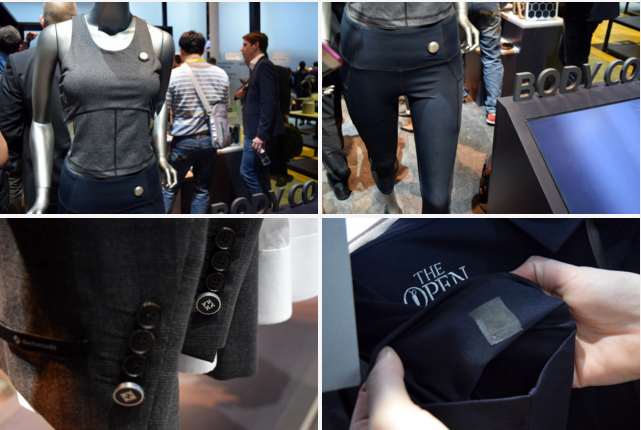Why smart clothes, not watches, are the future of wearables

Get this crap off of my wrist.
Why are we so fixated on watches and bands? The wearable tech market is full of fitness-obsessed products for workout-loving people with thick wrists and deep pockets. No one in the industry wants to admit it, but the wrist is probably not the best place to stick a bunch of sensors, and activity tracking may not even be the best use for all those sensors. If we want wearables to become truly wearable, companies need to start looking at the clothes we wear every day of our lives. And if we want those wearables to be truly useful, we need to think beyond step counting and create tech that gives actionable suggestions to improve our well-being.
Forget bands, make more smart clothes
Although the idea of smart clothing has floated around for a few years, little has come of it, until now. Big-name companies like Samsung, Google, OMSignal, Hexo Skin, and Under Armour have begun thinking about ways to make the clothes on your back as smart as the phone in your pocket. Since most wearables are fitness-focused, most smart clothing so far has followed in those footsteps with incredibly accurate fitness metrics and detailed analysis of workouts. Thankfully, many companies are beginning to think beyond gym rats, and the smart clothes they are working on may be the future of wearable tech.
No matter your age, gender, or fitness level, you have one choice every day: wear clothes or get arrested for indecent exposure. This is why smart clothes are wearables for everyone. Slipping on a smart t-shirt or hooking on a smart bra in the morning doesn’t require any extra effort. You don’t have to change your behavior to suit the tech.
Endless varieties of smart clothes
Smart clothes are even more normal looking, and they’re much more easily customizable than other wearables. After you’ve got the sensors down, you can easily incorporate them into any type of clothing without a hitch. It doesn’t take much effort to create 20 different color options and styles for a smart shirt, but manufacturing more than one finish for a smartwatch is a huge operation. Already, smart clothes are available in more styles, colors, and varieties than other wearables.
Just look at OMSignal’s many fun smart sports bra patterns and color options orSamsung’s recent wearable prototypes, which include a belt that lets you know when you’re packing on the pounds, a very stylish business suit with NFC buttons hidden in the cuffs, a golf shirt that tracks swings, and smart workout clothes. All of these devices are brilliant wearables, not because they share the same tech as your average fitness tracker, but because they don’t look like tech.

It's a dream shared by many, including the founder of Google Project Jacquard, Ivan Poupyrev. During Google I/O 2015, Poupyrev showed off a new way to weave touch panels to into conventional fabrics, using old-fashioned textile manufacturing processes. Google’s yarn has a conductive metal core that’s mixed with conventional fibers and can be dyed any color. Google is working with Levi’s and other companies to make its dream of high-tech clothing come true using traditional techniques.
Noble Biomaterials makes CircuiteX technology, which creates the conductive components in smart garments. These threads “ultimately allow for the ‘detection, transmission and protection of electrical signals’ within smart clothing.” explains General Manager Bennett Fisher. “Once the sensor is inside the clothing, what you’re wearing becomes a sensor.”
Clothing+ is a Finnish company working on integrating technology like this into clothes for sports and medical applications. “People are more and more interested in understanding their bodies and making choices based on data,” Mikko Malmivaara, one of the founders of Clothing+, told us. And as this interest grows, Malmivaara noted, Clothing+ determined that the “clothes we wear are the best way for any device or data system to interface the human body.”

Although it may be a while before Fruit of the Loom starts selling smart boxers at K-Mart and Victoria Secret kicks off a marketing campaign for the Dream Angels smart bra, tech is slowly making its way into our clothes, albeit in small ways. Ralph Lauren sells a smart tennis shirt by OMSignal, Tommy Hilfiger has a solar-powered jacket, and Joe’s Jeans recently made a pair of skinny jeans for women that have a special pocket for charging up your iPhone 6 on the go. High-tech accessories like purses and backpacks that charge your gadgets on the go are already popular among the tech-savvy populous.It’s only a matter of time before having smart clothes and accessories becomes the norm and people start to wonder why they’d even bother buying a piece of clothing if it isn’t smart.
Smart underwear is the way to go
Funny enough, the gateway drug of the smart clothes world was fitness clothes, but a more logical choice is perhaps the most intimate one of all: underwear. Most people wear underwear every day — unless you like to go commando — and it’d be an easy way to get people started with smart clothing. In fact, if you didn’t want to wear tons of smart clothing or spend the money on techy clothes, you could get along just fine with a collection of smart socks and underwear.
Your underwear is also the most logical place to wear sensors that monitor your vitals, as it’s the clothing that’s in closest contact with your skin. A smart bra can measure breathing, heart rate, and muscle tension to determine a number of health and wellness metrics like stress level, activity, anxiety, and so on. Same goes for a pair of smart boxers, socks, or an undershirt.
Current fitness bands try to get all that data from your wrist, which is a tricky spot for certain metrics, especially muscle tension and breathing rate. Activity tracking at the wrist isn’t always the most accurate, either. Even popular fitness trackers like Fitbit exaggerate step count and can misread enthusiastic hand gestures for dozens of steps. Right now, the accuracy of fitness bands is at the mercy of each company’s algorithms and companion app. That doesn’t have to be the case. Most researchers agree that placing trackers on your hip or foot would offer more accurate measurements than wrist-based fitness trackers and smartwatches, so why not stick all those sensors in your socks or underwear?
Fitness companies who make smart clothes are already jumping all over that idea. OMSignal and Sensoria have smart bras and smart workout shirts that can be worn under regular clothes or at the gym, Sensoria makes a pair of smart socks with an attachable sensor and conductive thread, and Hexo Skin offers several smart shirts that are similar to those from OMSignal and Sensoria.
The next logical step is to put this tech into normal underwear and clothes to track wellness metrics instead of just fitness. After all, not everyone is a gym rat, but most people would like to know how they’re doing, if they’re stressed, and how much exercise they’ve gotten.
Taking wearables out of the gym
OMSignal’s cofounder and CEO Stephane Marceau paints an incredible picture of a future in which everyone wears smart clothes that give them actionable feedback when they need it most. The company currently has a series of smart sports shirts for men and it just launched a smart sports bra for women, both of which track your typical fitness metrics of steps, distance, calorie burn, and heart rate, as well as many other unique measurements like breathing efficiency, fatigue levels, and how much effort your body is putting into your workout.
The most exciting thing about OMSignal’s tech is that the data it garners from all the sensors in its clothes can be used for more than just workout analysis. Its next big project is tracking users’ emotional wellness with biometric data like breathing, heart rate, and muscle tension. When you’re stressed out, your breathing becomes shallow, your heart rate increases, and your body tenses up. OMSignal’s smart bra or shirt can recognize all these physical changes in your body and alert you via a push notification to stop, breathe, tune into yourself, and be mindful of your emotional state, thus improving your mental and physical well-being.

The company also hopes to enter the medical side of wearable tech with its smart clothes. In the future, pregnant women might be able to share their baby’s heartbeat with OMSignal’s app via the data captured by the sensors in its smart shirts. People with heart conditions or other medical issues could be alerted to physiological changes and warning signs before an emergency strikes. Smart clothing could notify you, your loved ones, and even medical personnel that you’re in need of help.
The possibilities are endless. Smart clothing has the potential to break wearables out of their fitness funk and make them go mainstream. If wearables are ever going to take off, they have to be fashionable, look like normal clothes and accessories, and do more than tell you your step count.
If you are ready to upgrade for your clothing brand, welcome to contact us by sending an e-mail to sales@eleheat.com.cn, Eleheat will provide you professional One-Stop Solution for Smart Clothing, Make you Clothing more Functional and Comfortable.
